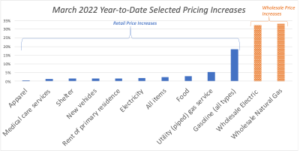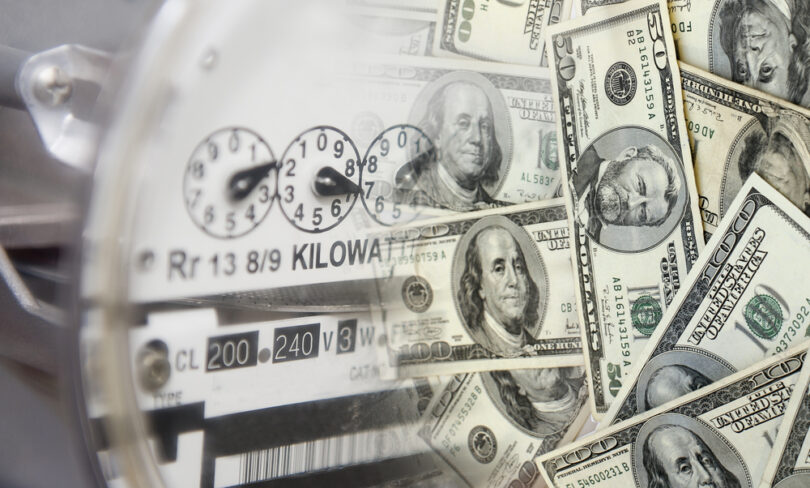The Next Big Inflation Story
We read a lot about inflation these days, and it’s not surprising. Consumers everywhere are feeling the pinch of rising costs. Although wages are increasing rapidly, the costs of many goods and services are growing even faster. So far this year alone, gasoline prices are up a whopping 18%, exacerbated by increased post-Covid demand, as well as new supply constraints arising from the war in Ukraine.
But the real inflation story is one that has barely begun to unfold—the rising costs of consumer electricity and gas. Why do gasoline prices get top billing over home energy prices? The most understandable reason is that the impact of wholesale market changes on gasoline are felt almost immediately at the pump, whereas in the retail natural gas and electric industries, wholesale pricing changes can take months or years to be fully felt by retail consumers.
In competitive retail energy markets, many consumers choose fixed-price products that protect them from the vacillations of the wholesale markets, often for several years. Similarly, in all US competitive retail energy markets other than Texas, the utilities continue to offer regulated default rates that are typically set semi-annually, and there is thus a long lag before wholesale prices are fully baked into default rates. However, in the longer run, after these initial lag periods of retail price protection for retail consumers, wholesale pricing will have to be incorporated into the prices consumers pay.
The likely impact of this will be significant. The chart below shows the retail pricing increases for various goods/services the first 3 months of the year, based on Bureau of Labor & Statistics CPI data, as well as wholesale energy costs in the PJM area of the US for residential customer profiles. As can be seen, the magnitude of other consumer cost increases seen so far this year, including gasoline price increases, are eclipsed by the increases in wholesale energy costs. What’s more, the chart below only captures the wholesale energy price increases from January through March of 2022. If you look at these price changes over the last year, the increase is over 100%.

What do these changes mean for our industry? The impacts will likely be far-reaching, both in terms of consumer and regulatory impacts, as well as financial impacts on various industry participants.
As these large wholesale pricing increases are ultimately passed on to consumers, it will hit pocketbooks hard. Because retail energy companies and utilities are closer to consumers than power plant owners are, they will bear the brunt of the blame with many consumers (and some regulators). Although this may seem unfair, it should be expected. Consumers hit particularly hard will be those who are currently on variable price products, and those rolling off of fixed price products, where they will immediately feel the impact of the new wholesale market that has more than doubled since the time they signed onto the prior fixed price term.
With industry participants, owners of generation and storage seem like the most obvious winners, particularly those with unhedged production. Many retail energy companies will sustain significant financial hits, particularly those that have large fixed-price books or who bear increased collateral costs with rising wholesale. Even where fixed-price books are well hedged, the financial impact of load forecasting errors will now be greatly amplified, as any increases in customer load (above what was forecasted) will have to be purchased under the highly elevated costs of current wholesale markets. Some of this industry damage can already be seen, with almost a dozen competitors announcing challenges ranging from bankruptcies to drops to Utility Default Rates or Provider of Last Resort, to halting retail sales until wholesale markets normalize.
As with all major disruptive changes, there could be some positive impacts that will emerge from the current wholesale crisis. First off, many consumers in this environment will come to appreciate the value of price protection, with the ability to lock in energy prices for years to mitigate against monthly price volatility. Price protection is central to many retail energy value propositions, and consumers will be ascribing much more value to it.
Additionally, as is often said, the cure for high prices is high prices. The increased wholesale prices should send signals to encourage generators to build more capacity, and consumers to reduce consumption, both of which will put downward pressure on wholesale prices. Ultimately, what goes up usually comes down. And since Utility Default Rates always lag wholesale markets, when wholesale comes down, there will be ample opportunity for retailers to win customers over from regulated rates to competitive products that offer savings and price stability, as well as other benefits which the utilities don’t offer, like positively impacting climate change and encouraging a cleaner environment.
By: Paul Keene, CEO, Tomorrow Energy



